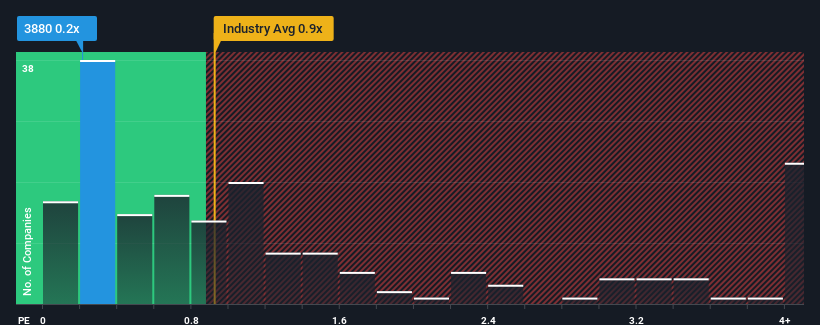- Japan
- /
- Paper and Forestry Products
- /
- TSE:3880
Risks Still Elevated At These Prices As Daio Paper Corporation (TSE:3880) Shares Dive 25%
The Daio Paper Corporation (TSE:3880) share price has fared very poorly over the last month, falling by a substantial 25%. The drop over the last 30 days has capped off a tough year for shareholders, with the share price down 24% in that time.
In spite of the heavy fall in price, it's still not a stretch to say that Daio Paper's price-to-sales (or "P/S") ratio of 0.2x right now seems quite "middle-of-the-road" compared to the Forestry industry in Japan, where the median P/S ratio is around 0.3x. Although, it's not wise to simply ignore the P/S without explanation as investors may be disregarding a distinct opportunity or a costly mistake.
Check out our latest analysis for Daio Paper

What Does Daio Paper's P/S Mean For Shareholders?
Recent times have been pleasing for Daio Paper as its revenue has risen in spite of the industry's average revenue going into reverse. One possibility is that the P/S ratio is moderate because investors think the company's revenue will be less resilient moving forward. If you like the company, you'd be hoping this isn't the case so that you could potentially pick up some stock while it's not quite in favour.
If you'd like to see what analysts are forecasting going forward, you should check out our free report on Daio Paper.Do Revenue Forecasts Match The P/S Ratio?
The only time you'd be comfortable seeing a P/S like Daio Paper's is when the company's growth is tracking the industry closely.
Taking a look back first, we see that the company managed to grow revenues by a handy 3.9% last year. The solid recent performance means it was also able to grow revenue by 19% in total over the last three years. Therefore, it's fair to say the revenue growth recently has been respectable for the company.
Looking ahead now, revenue is anticipated to climb by 1.4% per annum during the coming three years according to the two analysts following the company. That's shaping up to be materially lower than the 9.0% per year growth forecast for the broader industry.
With this information, we find it interesting that Daio Paper is trading at a fairly similar P/S compared to the industry. It seems most investors are ignoring the fairly limited growth expectations and are willing to pay up for exposure to the stock. These shareholders may be setting themselves up for future disappointment if the P/S falls to levels more in line with the growth outlook.
What Does Daio Paper's P/S Mean For Investors?
With its share price dropping off a cliff, the P/S for Daio Paper looks to be in line with the rest of the Forestry industry. Generally, our preference is to limit the use of the price-to-sales ratio to establishing what the market thinks about the overall health of a company.
Given that Daio Paper's revenue growth projections are relatively subdued in comparison to the wider industry, it comes as a surprise to see it trading at its current P/S ratio. At present, we aren't confident in the P/S as the predicted future revenues aren't likely to support a more positive sentiment for long. This places shareholders' investments at risk and potential investors in danger of paying an unnecessary premium.
Before you take the next step, you should know about the 2 warning signs for Daio Paper (1 doesn't sit too well with us!) that we have uncovered.
If these risks are making you reconsider your opinion on Daio Paper, explore our interactive list of high quality stocks to get an idea of what else is out there.
New: Manage All Your Stock Portfolios in One Place
We've created the ultimate portfolio companion for stock investors, and it's free.
• Connect an unlimited number of Portfolios and see your total in one currency
• Be alerted to new Warning Signs or Risks via email or mobile
• Track the Fair Value of your stocks
Have feedback on this article? Concerned about the content? Get in touch with us directly. Alternatively, email editorial-team (at) simplywallst.com.
This article by Simply Wall St is general in nature. We provide commentary based on historical data and analyst forecasts only using an unbiased methodology and our articles are not intended to be financial advice. It does not constitute a recommendation to buy or sell any stock, and does not take account of your objectives, or your financial situation. We aim to bring you long-term focused analysis driven by fundamental data. Note that our analysis may not factor in the latest price-sensitive company announcements or qualitative material. Simply Wall St has no position in any stocks mentioned.
About TSE:3880
Daio Paper
Manufactures and sales paper products in Japan, East Asia, Southeast Asia, Brazil, and internationally.
Undervalued with moderate growth potential.
Market Insights
Community Narratives




